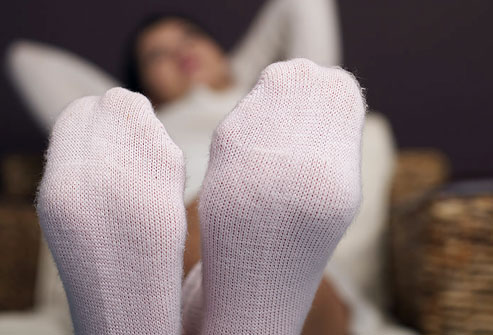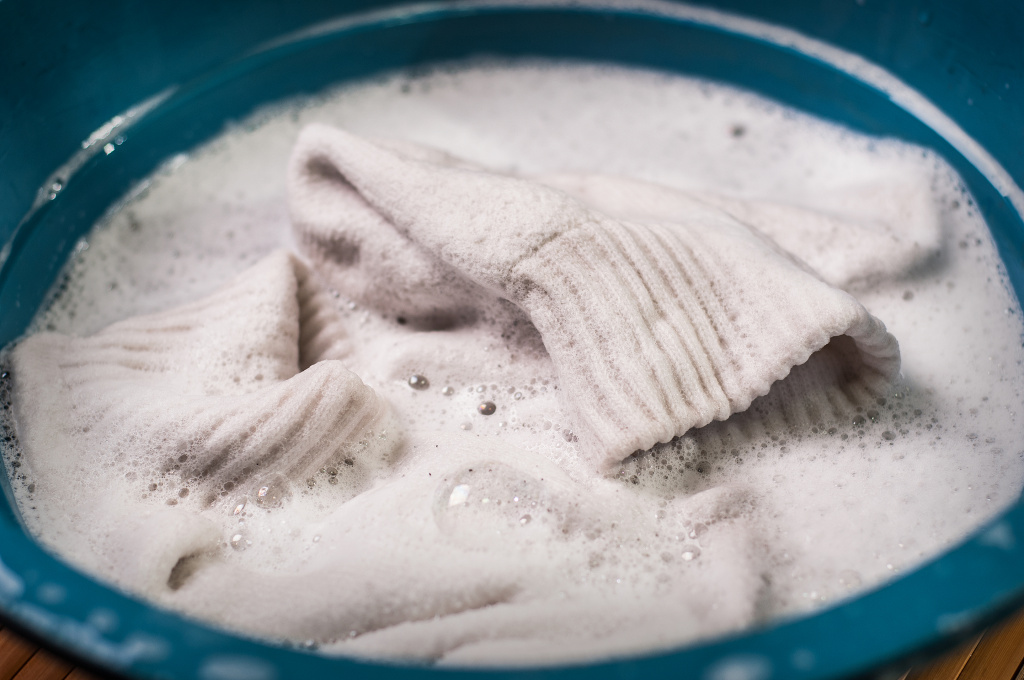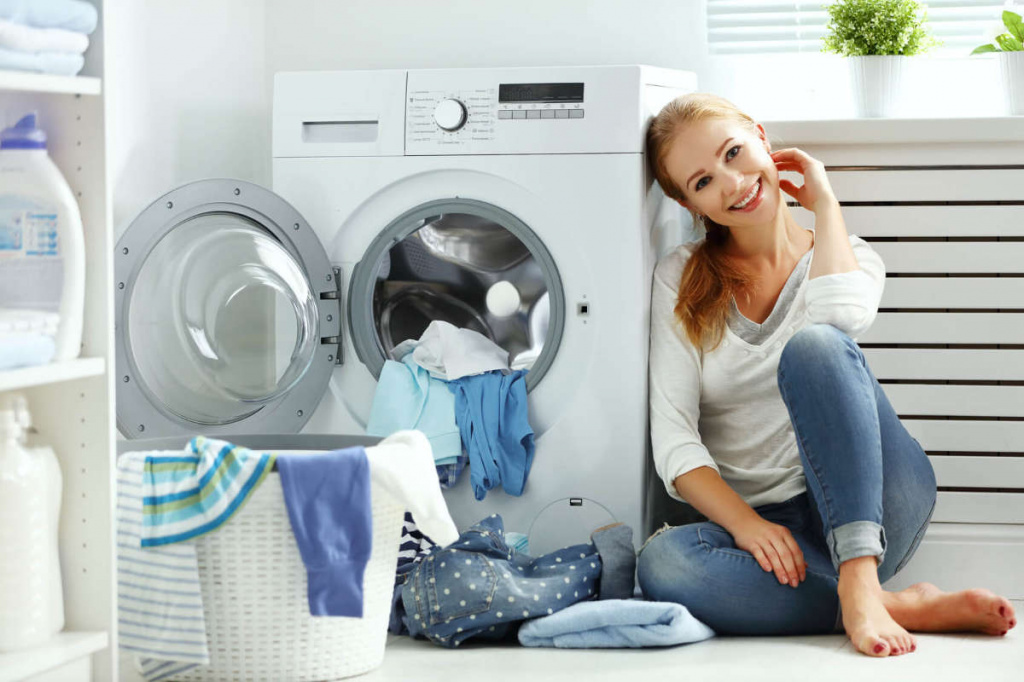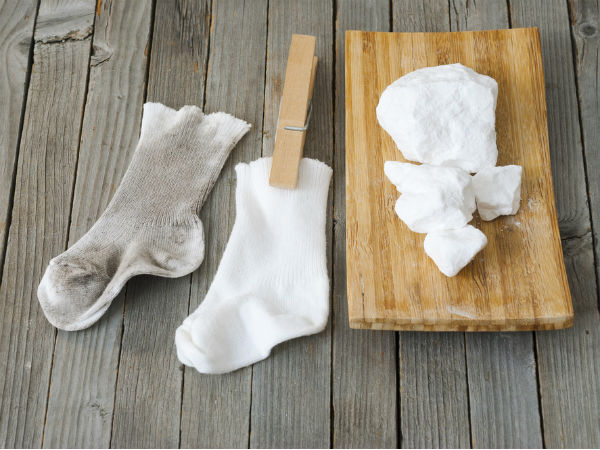
How to wash socks in the machine and by hand
Socks are a hot topic for modern fashionistas. Some copies are like works of art. Therefore, more and more often the question arises of how to properly care for an important part of the wardrobe. Moms of toddlers are puzzled by this issue, since children’s socks get dirty quickly, like all the clothes of little explorers. And, even for those people who choose conservatism, the issue of sock care arises daily.
If you want to keep your socks looking their best for as long as possible, follow our tips.
How often should you wash your socks

The usual procedure for replacing socks comes down to the following rule: change daily, wash as you accumulate or need.
It is not at all necessary to start the washing machine because of one pair. Also, do not wash socks separately from other clothes. The main thing is to sort by color and type of fabric.
In case of emergency, you can quickly wash the socks by hand.
The rule changes if you put a stain on the jersey. In this case, you do not need to postpone washing indefinitely. Remember: the fresher the stain, the easier it is to remove.
To save time and choose the right solution, we offer a small checklist:
-
Socks need to be changed daily. A light degree of soiling will avoid rough washing, which leads to deformation of knitwear and the formation of pellets.
-
Wash as needed, or when enough socks have accumulated that you think you can turn on the washing machine.
-
When storing in a laundry basket, it is advisable to put one sock into another. In this case, you will save yourself the trouble of looking for a pair. If possible, collect dirty socks in a separate container.
-
We recommend that you immediately wash heavy dirt and stains. Old dirt penetrates deep into the fibers and is much more difficult to wash off. There is a need to use stain removers and bleaches.
Rules for washing knitwear
The general rules for washing textiles also apply to washing socks. Here are the most rational requirements:
-
Separate knitwear by color. Some specimens may shed heavily.
-
Before washing, be sure to turn your socks inside out to remove dust accumulated there.
-
To prevent socks from getting lost among clothes, put them in a special laundry net or adapt a pillowcase with a zipper for this.
-
Choose the right temperature setting. Cotton products withstand heat up to 100 degrees. You can even boil them. For synthetics, a mode with a temperature not higher than 60 degrees is suitable. Woollens are best washed by hand in lukewarm water.
-
As detergents, choose ordinary washing powders, enzyme detergents, soaps, fabric softeners.
Machine wash
For those who are faced with this question for the first time, let’s break down the process of washing socks with a machine.
Necessary equipment
Before you start washing, make sure you have the right supplies and equipment. We will need:
-
Washing machine.
-
Mesh bag with a zipper (optional).
-
Powder or liquid detergent.
-
Laundry soap, bleach, stain remover.
-
Rinse aid (conditioner) for linen.
Preparing for washing
Before sending sock knitwear to the drum of the machine, you need to perform preparatory procedures:
-
Sort your socks by color. Dark, light and colored should be washed separately. If all socks are of different colors, choose things that are close in shades or test for dye fastness. To do this, wet the product and attach a light napkin to it. Shedding fabrics will immediately give themselves away by painting the napkin in the appropriate color.
-
If the sole is already fairly trampled, the white products have become gray, and the black ones have become glossy, it is necessary to wash the socks first. To do this, turn the jersey inside out, wet it, rub it with laundry soap and leave it to lie down for 15-30 minutes. Then rub the products a little, rinse and send them to the machine.
-
In case of heavy soiling, before washing, use the bleaching and stain removal methods that we will suggest later in the article.
Mode selection and washing
Now we send the prepared socks to the big wash. To do this, follow our instructions:
-
Load things of the same color into the drum and close it.
-
Select a washing programme. Wash sufficiently soiled items in the usual way, which includes a full wash cycle, rinsing and spinning. If the laundry only needs to be refreshed, you should use the quick wash cycle. If necessary, use the appropriate buttons to adjust the water temperature and spin power.
-
Pour the required amount of powder into the powder compartment up to the mark. If you are using fast mode, you can cut the powder dose in half. Place the liquid product in capsules into the drum.
-
Press the start button.
-
After stopping the drum and unlocking the machine door, remove the laundry immediately. Prolonged exposure to wet textiles in an enclosed space can cause an unpleasant odor.
-
Hang things out to dry. Avoid drying white socks on a metal radiator. This can lead to rust spots that are very difficult to remove.
-
Store your socks in a dry place by stacking them one inside the other.
These recommendations apply to the care of any type of socks: adults and children. The only exception for washing children’s clothes is the use of hypoallergenic detergents.
Handwash
This type of washing is considered delicate and has a whole set of advantages:
-
A useful skill is useful if it is not possible to wash things in the car: while traveling or in the event of a power outage.
-
The use of manual labor saves water and energy consumption.
-
Significantly less chance of damage to products, their deformation and molting.
At the same time, hand washing requires free time and physical effort.
Peculiarities
The procedure for washing socks by hand is different. that all actions are performed manually: from washing to spinning.
Sequencing:
-
Sort items by color.
-
For heavy soiling, pre-wash, stain remove or bleach.
-
Type in a basin or other container about 10 cm of water.
-
The water temperature should not be high and comfortable for the hands. When washing woolen socks, use water at room temperature.
-
Protect sensitive skin with rubber gloves.
-
Dissolve the right amount of powder in water. Usually 3 liters. 0.5 tbsp required powder.
-
Put your socks in a container and let them soak for 5 minutes. At this time, you can stir things by making circular movements with your palm.
-
After that, do a general wash: take things with your hands and rub them together. Most of the dust and light dirt will go away already at this stage.
-
Now move on to the individual wash. Take each sock and rub it between your fingers, moving along the entire length. Dip the jersey in water and rub again.
-
Wring out clean clothes and put them separately for further rinsing. You can immediately put a basin with clean water next to it.
-
Rinse washed socks thoroughly to remove detergent residue. To do this, you can use running tap water or alternately rinse in a container of clean water. If desired, add fabric softener to the final rinse.
-
Wring out the jersey thoroughly and hang it up to dry. The best option is to dry in the fresh air or in a draft.
Pre-treatment agents for heavy soiling

As promised, here are additional products that will help get rid of heavy pollution and stains. The proposed funds are prepared independently from the available components. You can also use special household chemicals.
Homemade composition for dirty white and colored socks
This method includes the most common components and is suitable for processing heavily soiled items. Removes old stains and dirt. Do not use this product on wool socks.
For work you will need:
-
water (cold and hot);
-
laundry soap;
-
washing powder;
-
table salt;
-
baking soda;
-
ammonia solution (ammonia);
-
metal saucepan;
Sequencing:
-
Wet your socks and wash them with laundry soap.
-
Rub the knitwear with the same soap, leave for 30-60 minutes, then rinse.
-
In a metal saucepan, put 2 tbsp. l. washing powder, 2 tbsp. l. salt, 2 tbsp. l. soda, 1 tbsp. l. ammonia. Pour the mixture with 2 liters of hot water (brought almost to a boil).
-
Put the socks into the solution, bring the liquid to a boil and boil for 5 minutes.
-
Let the container cool down. You can leave things in the solution overnight.
-
Take out the laundry and rinse in clean water.
Whitening agent for light colored socks
This method will restore snow-white freshness even to worn socks. The components are in every home or are available for purchase at the nearest store.
To prepare bleach you will need:
-
plastic basin;
-
3 liters of warm water;
-
1 st. l. hydrogen peroxide;
-
2 tbsp. l. aqueous solution of ammonia (ammonia).
Before soaking in the solution, wash the socks by hand with laundry soap. If heavily soiled, leave the soapy socks for 10-15 minutes and then wash them again.
Whitening process:
-
Pour water into a plastic basin and add the required amount of hydrogen peroxide and ammonia to it. Mix ingredients thoroughly.
-
Put your socks in the solution and leave for a while. The bleaching period depends on the degree of soiling of things. Sometimes it may take up to 2 hours.
-
After bleaching, wash again with laundry soap or detergent.
-
Rinse your knitwear well.
Laundry soap for white and colored socks

We will use simple laundry soap. This old tried and tested tool helps out in different situations. It will also help in washing socks.
The usage method is extremely simple:
-
Wet your socks and wash them with soap.
-
Lather things thickly with laundry soap. Put them in a plastic bag and leave for 12 hours (you can overnight).
-
Take out the treated knitwear, rub it well and rinse it in running water.
Household chemicals
The special composition of bleaching and stain-removing agents is designed to be gentle on fabric fibers and dyes. However, with frequent use of chemicals, the fabric becomes thinner and things become unusable. After 5-7 washes with chlorine bleach, socks can be thrown away. In addition, not all things are made from natural white fibers. Often the fabric is simply dyed white. And with intense exposure to detergents, the paint is washed off, and things become gray or yellow.
To restore the purity and whiteness of your favorite socks, you can buy any of the following products:
-
Bos maximum. Suitable for colored and white fabrics. Working temperature range from 30 to 50 degrees Celsius. -
Sarma Active. Powdered bleach. Can be used for hand and machine wash. Not effective at low water temperatures. To remove difficult stains, several treatments are required. Cannot be used on silk and wool. -
Vanish oxy action. Fast action liquid. Effectively removes even the most stubborn stains. Begins to act already at low water temperatures. You can soak clothes in the prepared solution, or you can apply pointwise to the places of contamination. Suitable for delicate fabrics. -
Persol. Domestic powder detergent for white and colored linen perfectly copes with various stains, removes yellowness and gray plaque. It is most effective at a water temperature of 50 degrees Celsius. -
Chirton. Works in both hot and cold water. Removes stubborn dirt from colored and light products. -
Eared nanny. Suitable for washing children’s clothes because it contains non-toxic ingredients. -
Umka. Another safe bleach for baby clothes. It consists of a soapy solution with active oxygen.
These products are an excellent alternative to chlorine bleaches. Please read the instructions for use before using them. Properly maintained concentration and time will allow you to get the best result.
Washing baby socks
A feature of caring for children’s things is the use of special products that do not cause irritation of sensitive children’s skin. The washing process itself is no different from the usual. You can use manual and automated processing. The main aspects are the preservation of the softness and purity of things.
Socks are an important attribute for a person of any age and status. Following our simple instructions, you can easily keep the freshness of your linen, please your loved ones and gain confidence in the impeccability of your appearance.

Добавить комментарий
Для отправки комментария вам необходимо авторизоваться.